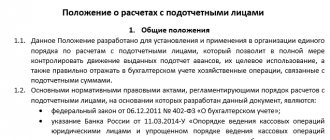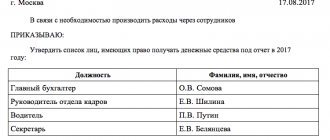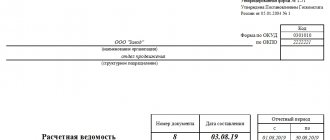What an accountant needs to remember when issuing money for reporting
The issuance of money on account is regulated by the instruction of the Bank of the Russian Federation dated March 11, 2014 No. 3210-U, which establishes the procedure for conducting cash transactions (hereinafter referred to as procedure No. 3210-U). Based on its provisions, there are 3 main points that every accountant needs to remember when issuing money for reporting:
- Accountable funds are issued on the basis of a written application from the person receiving the funds or an order from the manager. The required details of such an application include (except for the full name, position and signature of the applicant): the amount of accountable funds, the period for which the money is issued, the date and signature of the manager who authorized the release of funds into account (clause 6.3 of order No. 3210- U). A sample application can be viewed on our website.
ATTENTION! From November 30, 2020, an administrative document can be drawn up for several cash payments to one or more employees. In this case, you need to indicate the name, amount and period for which the money is issued for each employee.
What other innovations in the procedure for recording cash transactions have come into effect, ConsultantPlus experts told. Get trial access to the K+ system and go to the review material for free.
2. The deadlines for issuing money for reporting may be established by accounting policies or a separate order. This will make it easier for accountable persons to write statements, and for an accountant to check the timing of refunds. Legislatively, there are no established boundaries for the periods for which money is issued for reporting purposes. Each enterprise resolves this issue independently.
IMPORTANT! The enterprise must have an order stating who has the right to receive money on account. We have a sample of such an order on our website.
- The accountable person is obliged to report the accountable amount or return unused funds to the enterprise's cash desk within the number of days established by the employer after the end of the period for which he was given the money. If the money was issued for a business trip, the accountable person is obliged to report within the period established by the employer after returning.
Another important nuance is the maximum possible amount that can be reported. This has its limitations.
We recommend that you look at the material “What amount can be issued for reporting in 2021 - 2021?”
Is it possible to deduct accountable amounts from wages?
The employer can fix the list of persons to whom funds can be issued on account by issuing an order (although this is not necessary). Any employee of the enterprise can become an accountable person.
Funds against the report can be issued to employees in cash or in non-cash format to a bank account. Once the funds are received, the employee will have to account for them.
Such a report means the employee providing the employer with documentary evidence of the amount of expenses and returning unspent accountable amounts to the employer. If the accountable amounts were issued in cash, then the employee must provide a report within 3 working days after the expiration of the period for which they were issued to him or from the day the employee returns to work (for example, after his return from a business trip). This requirement is specified in clause 6.3 of the Central Bank Directive of 2014 No. 3210-U.
The law does not prohibit issuing accountable amounts to employees, even if they have not reported on previous ones.
The employer independently approves the deadlines for issuing accountable amounts and enshrines them in local regulations (for example, in the internal Regulations on settlements with accountable persons).
With regard to reportable amounts that were issued in non-cash form, the employer must decide in advance on two aspects: for what period the reportable amounts are issued, and what is the final date for reporting by employees.
If the employee has not reported on the accountable amounts given to him, then the employer can withhold them from his salary. At the same time, he needs to take into account some legislative nuances. The procedure for withholding accountable amounts is regulated by Art. 137 Labor Code.
The issuance of money to employees on account is regulated by Central Bank Directive No. 3210-U dated 2014, which establishes the procedure for conducting cash transactions.
How an accountable person must report
To write off money received from an employee, there is a prescribed form called an “Advance report”. The advance report form (AO) in the columns on the expenditure of amounts is filled out by the accountable person independently. The JSC is accompanied by primary documents confirming the fact of expenditure.
For a sample of filling out an advance report, see here.
In the corresponding columns of the table on the reverse side of the JSC form, the accountable person indicates:
- serial number of the record;
- date of expenditure of funds (issue of the primary document);
- number of the primary document;
- name of the primary document;
- amount of expense.
If daily expenses that do not have primary documents are written off, the date of the expense is indicated and the daily allowance approved by the enterprise is entered. You should also indicate the number of the order on the basis of which the daily allowance was issued to the business traveler.
In the final line of the form, the accountable person enters the amount of funds spent. The accountant checks the correspondence of the amount in the report with the amount of funds received by the accountable person.
If the amount on the advance report is greater than what was issued to the accountable person, then an additional payment is made to the accountable person from the cash desk of the enterprise or (at his request) to a bank card.
How to do this correctly, see here “Transferring a sub-report to an employee’s card from a current account.”
If the amount of funds written off according to the advance report is less than what was issued to the accountant, he is obliged to return the remaining money to the enterprise. If the accountable person does not return the balance of unspent (not written off according to the advance report) funds or does not report within the specified time frame, he or she becomes indebted to the enterprise for the amounts received in the account.
Upon dismissal
Sometimes, at the time of dismissal, an employee has an outstanding amount of accountable amounts.
If the employee’s consent to withhold has already been taken, and an order for the enterprise has been issued, a recovery of no more than 20% is also made from the calculated amounts.
The employee can voluntarily deposit the balance of the debt into the company's cash desk upon receipt of the payment upon dismissal.
To do this, the accountant prints outgoing and incoming cash orders at the same time.
When the amount of debt is revealed immediately at the time of dismissal, the employer must follow the same course of action as with a working employee.
If an employee does not want to pay the outstanding amount, the employer does not have the right to delay his dismissal.
He can collect the amount of the debt after it has been settled.
To do this, you must first submit a statement of claim to the court, then with a court order to the bailiffs.
Methods of deduction of funds from wages and standard entries for repayment of accounts
There are 3 possible scenarios:
- The accountable person acknowledges the debt and writes an application to withhold funds received on account for which he owes money from his salary.
- The employer retains the debt of the accountable on his own initiative. This situation, in turn, suggests 2 possible scenarios:
- when the reporting person does not dispute the debt, the enterprise, within a month from the end of the deadline by which the employee was supposed to report, may decide to withhold the money;
- when the accountable person does not agree with the fact of the debt, only the court can make a decision to withhold money.
- The manager decided to forgive the debt to the accountable person.
In the first case, when the accountable person acknowledges the debt and writes an application with a request to withhold the accountable money from his salary, the entire amount of the debt can be withheld at a time, unless otherwise indicated in the application for withholding (letter of Rostrud dated September 26, 2012 No. PG/7156-6- 1).
In the second case, when the accountant does not dispute the fact of the debt, the accountant has the right to withhold the debt from the employee. To do this, it is necessary to make a decision (issue an order) to withhold the debt within a month from the date set for submitting the advance report to the accounting department or returning the imputed amounts. The order must include the signature of the employee, indicating that he has no objections. This norm is established by Art. 137 Labor Code of the Russian Federation.
Important! ConsultantPlus warns that the maximum amount of deductions from an employee’s salary is 20% of the accrued amount minus personal income tax (Article 138 of the Labor Code of the Russian Federation, Letter of the Ministry of Health and Social Development of Russia dated November 16, 2011 N 22-2-4852). Therefore, if the unreturned accountable amount exceeds 20% of the accrued salary minus personal income tax, then... See K+ for more details. Trial access is available for free.
Here are typical transactions for the operations discussed above:
| Dt | CT | Operation description |
| 71 | 50 | Issuance of cash from the company's cash desk |
| 94 | 71 | Reflects debt on unreturned accountable funds |
| 20–44 | 70 | Employee's salary accrued |
| 70 | 68 | Personal income tax withheld from salary |
| 70 | 94 | Employee debt repaid |
In the case where the accountable person disputes the debt, only the court can resolve the issue. At the same time, after a month from the last reporting date, the accountant is obliged to accrue additional insurance premiums for the amount of unreturned accountable funds (Articles 7, 8 of Law No. 212-FZ dated July 24, 2009). As for personal income tax, it is accrued upon the fact that the debt is written off in connection with a court decision (if the court made a decision in favor of the employee) or on the date the debt is forgiven.
Debt forgiveness is the last possible development of events in the event of non-repayment of accountable amounts. If a decision is made to forgive the debt of an accountable person, it is necessary to issue an appropriate order (you can also limit yourself to receiving the appropriate resolution from the manager on the accountable person’s application to forgive his debt).
The date of the resolution (or order) is considered the date the debt is written off from the debtor (clause 2 of Article 415 of the Civil Code of the Russian Federation).
Whether the written-off debt of an accountant is subject to personal income tax and insurance premiums and what to do with income tax, find out in the Ready-made solution from ConsultantPlus by getting trial access to the system for free.
Postings when forgiving a debt on an unreturned account look like this:
| Dt | CT | Operation description |
| 91 | 71 | Debt written off based on order |
| 70 | 68 | Personal income tax withheld from the amount of the written off debt |
| 91 | 69 | Contributions accrued on written-off debts |
Is the employee’s consent required to withhold an accountable amount?
An employee can return unspent funds in cash and deposit them into the company’s cash desk. But if he does not have the opportunity to repay the debt on time, then several options are allowed for deducting it from his salary.
Labor Code in Art. 137 provides for the employer’s right to return unspent accountable amounts. Refunds are available in several options:
- At the request of the employee . In this case, the employee writes a free-form application addressed to the employer, where he asks to withhold accountable amounts from his income.
- By decision of the employer through the issuance of an order to withhold accountable amounts from the employee.
It is impossible to obtain accountable amounts by order without the prior consent of the employee. The employee’s consent to withholding must be obtained in writing so that regulatory authorities do not have a reason to hold the employer liable.
Expert opinion
Gusev Vladislav Semenovich
Lawyer with 10 years of experience. Specializes in criminal law. Member of the Bar Association.
Consent may take the form of a statement from the employee, or he may sign the order to withhold the accountable amount and indicate there that he does not dispute the grounds for the withholding and the amount of the debt.
The employer can also provide the employee with a preliminary written notice of the amount of the upcoming deduction, where he must sign.
Also in practice, the following scenarios are possible:
- If there is a disagreement between the employer and the employee regarding the amount of debt, or the employee refuses to return the money voluntarily, then the employer must go to court . In this case, the limitation period for debt collection is three years.
- Company management may decide to write off debt by recognizing it as employee income . It is important to consider that this amount will become taxable income and personal income tax must be transferred from it from unused accountable amounts. Forgiveness of debt to an employee is formalized through the issuance of an appropriate order.
Results
When issuing imprest amounts, the enterprise accountant is obliged to keep records of the timing of their return. If the accountable does not timely report for the amounts issued (or does not return them), it is possible to deduct them from the salary. The procedure for such retention can be initiated by both the employee and the employer.
More information about how to collect a report from the director of an enterprise can be found in the article “Five effective ways to reset the accumulated report of a director.”
You can find more complete information on the topic in ConsultantPlus. Free trial access to the system for 2 days.
Rules for drawing up an order
The employer is obliged to issue an order to deduct from the salary within a month after it becomes aware of the employee’s debt. If the specified deadlines are missed, then you will have to go to court to collect the amount of the debt, or the employee will first have to write an application for withholding.
The employee draws up an application to withhold accountable amounts in a free format.
The order should include the following information:
- Employer company name.
- Title of the document.
- Full name of the accountable person and his position.
- Date of issue of the order and place (city).
- Circumstances of issuing the accountable amount : when it was issued and for what purposes (for example, in connection with a business trip).
- Amount of funds subject to withholding.
- List of attachments (this may be a notice of withholding, an advance report, or a written statement from the employee).
In the order, the head of the company can appoint a person responsible for withholding money from wages. Usually this is an accounting employee who is responsible for payroll.
The deduction is made on the next day of payment of wages. It can be made from both an advance payment and a final payment.
It is worth considering that even if there is a correctly executed order to withhold and the employee’s consent has been obtained, the employer is not always able to withhold the accountable amount that has not been returned to him at a time. This is due to the fact that the provisions of labor legislation limit the amount of deductions from the employee’s income.
How to collect funds from an employee’s earnings?
The employer sets for its personnel the period for which accountable amounts are issued.
Within 3 days after its end, employees must submit an advance report to the accounting department confirming the actual expenditure of funds for their intended purpose.
If the employee was on sick leave, on vacation or a business trip at that time, he has the right to make an advance report and return the remaining funds upon returning to his place of work.
If an employee has unspent money, he simply deposits it into the company’s cash desk. However, things don't always work out so smoothly.
Sometimes the employee is simply unable to make a return.
Then, based on the consent of the employee and the issued deduction order, the accountant can withhold the accountable amount from the salary in an amount not exceeding 20% of the monthly salary. This limitation is established by Art. 138 Labor Code of the Russian Federation.
The specified maximum withholding amount is calculated from income minus personal income tax.
Let's look at what this looks like using a specific example.
Accounts, postings
Accounting for accountable amounts is maintained in 71 accounts. If the balance of funds given to the employee in advance is not returned in a timely manner, the amount of the debt is considered a deficiency in the accounting records. Deductions of accountable amounts are carried out as a reduction in the amount of the shortfall attributed to a specific responsible person. Typical correspondence in this accounting segment is as follows:
- D71 – K50 or 51 – the issuance of money for reporting is reflected;
- D94 - K71 - unspent accountable amount not paid into the cash register on time is classified as a shortage;
- D70 - K94 - the balance of accountable funds was withheld from wages (with the written consent of the debtor);
- D73 - K94 - indicates a debt on accountable funds that cannot be repaid from the monthly earnings of an individual;
- D50 or 51 - K73 - a record is drawn up in situations where the employee voluntarily closes the debt and when the required amount is forcibly repaid by a court decision;
- D91 – K73 – recording the fact of debt forgiveness;
- D70 – K68 – income tax was calculated on the forgiven amount of debt;
- D91 - K69 - shows the accrual of insurance premiums on accountable amounts that moved from the group of debts to the category of employee income.
By law, an employee who has received funds is required to report on them no later than 3 days. This happens after the expiration of the period for which the money was issued or after going back to work if the return date fell on sick leave, vacation or a business trip.
Often in practice, you can encounter situations where employees report for a smaller amount, as a result, they develop a debt to the organization.
If a person has the opportunity, he deposits the amount of debt into the cash desk of the enterprise. Otherwise, the employer collects it from the salary.








